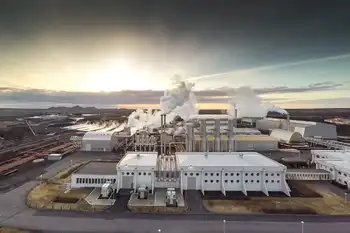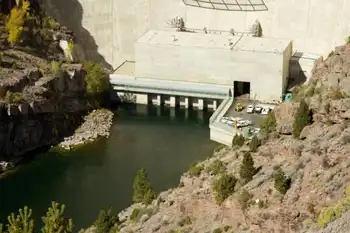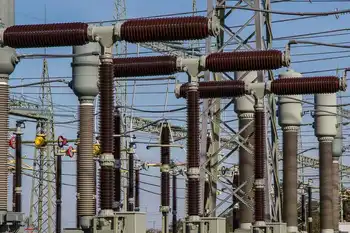Turbulent time for wind development in New York
By Associated Press
Arc Flash Training - CSA Z462 Electrical Safety
Our customized live online or in‑person group training can be delivered to your staff at your location.

- Live Online
- 6 hours Instructor-led
- Group Training Available
The nationwide financial crisis has put the brakes on a wind farm under construction in northern New York and another developer has aborted possible projects in eastern and central New York after trouble securing land. And wind energy companies are now being asked to abide by a code of ethics by Attorney General Andrew Cuomo — the upshot of his investigation into allegations of corrupt practices by developers.
Wind is still alive in New York and new turbines are still being planned for blustery parts of the state. But the last few tumultuous months have been tough for the industry nationwide and New York in particular.
"Obviously, it doesn't make it easy for the wind industry, like every other industry, to get financing," said Carol Murphy, executive director of Alliance for Clean Energy New York, which represents renewable energy companies. "But I have not heard of any of my members who've run into a brick wall.... There are still a lot of hedge funds and folks who are investing in green energy."
There are 10 wind projects running in New York with a combined potential to generate more than 700 megawatts of electricity. The largest, Maple Ridge along northern New York's Tug Hill, includes 195 turbines. But wind remains a relatively small player in New York, where all the wind farms combined generate less power than a large nuclear reactor.
That could change next year.
The Cohocton Wind project in the Finger Lakes region could be finished by the end of this year, according to a spokesman for First Wind of Newton, Mass. The High Sheldon Wind Farm in Wyoming County could be running by January, according to an Invenergy spokeswoman. And Essex, Conn.-based Noble Environmental Power has made progress on two projects in northern New York, according to supervisors of the local towns.
But there have been questions about Noble's projects amid its financial problems. The company announced plans this year to raise money through an initial public offering with underwriting from Lehman Brothers, which became the largest bankruptcy filing in U.S. history.
Noble officials did not respond to repeated calls and an e-mail seeking comment from The Associated Press.
However, Noble officials blamed financing problems when they suspended work on 14 towers in the northern Adirondack town of Bellmont, said town supervisor Bruce Russell. The company told Russell it could not start work again before the second half of 2009. Meanwhile, work is nearing completion on Noble wind farms in the neighboring towns of Chateaugay and Altona, said supervisors from those towns.
Noble and First Wind were investigated by Cuomo earlier this year amid allegations that developers were bribing local officials to push through wind projects. No charges were ever filed. Noble and First Wind last month became the first signatories of Cuomo's voluntary "Wind Industry Ethics Code," which is designed to make sure developers deal with local officials in a fair and transparent manner.
Siting 400-foot-high wind towers in heavily settled states like New York is difficult in the best of times. Developers operate under strict regulations and quite often face organized local opposition. Iberdrola Renewables is still trying to develop a project in Jordanville, southeast of Utica, five years after being granted a permit for a test tower. Project opponents have already sued once.
Shell WindEnergy recently ran into trouble securing enough land for potential projects on the Helderberg Escarpment west of Albany and in the Finger Lakes and shelved the projects, said company spokesman Timothy O'Leary.
But there also are national factors working against wind. Aside from the credit crunch, the plummeting price of oil has lessened the urgency for renewable fuels. Even oilman-turned-wind advocate T. Boone Pickens has dialed back spending on his wind and natural gas campaign.
While Congress recently renewed crucial production tax credits for wind production, the extension lasts only a year. Murphy said producers are looking for cues from the incoming Obama administration to see if they can plan for the extension long term.
"I think we'll know more as we get into a new presidency and a new year," Murphy said.
New York offers its own financial incentives for wind projects under a long-standing goal to rely on renewable resources for 25 percent of the state's electricity by 2013. State regulators only signed off this year on a deal allowed Iberdrola to buy out Energy East after the Spanish company promised to spend $200 million to develop wind projects in New York.
Iberdrola has a list of 10 wind projects in various stages of development, including the Jordanville project. It's not a sure thing all the projects will be approved.
There is still plenty of room for growth in New York, at least theoretically.
Bruce Bailey, a principal for the wind-mapping company AWS Truewind, said New York could potentially produce from 5,000 to 7,000 megawatts — or up to 10 times its current production. The richest potential is in wind-blown areas of the state like northern New York, the Southern Tier and west of the Catskills.
Bailey's estimate is based on wind potential and leaves aside issues like available grid connections, political concerns, available credit and the future energy market. Still, he said: "Getting halfway there is realistic in the next 10 years."











